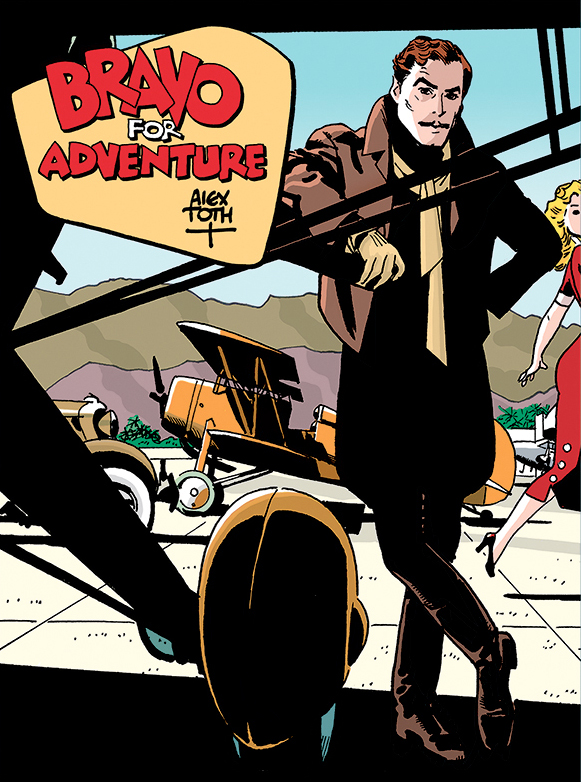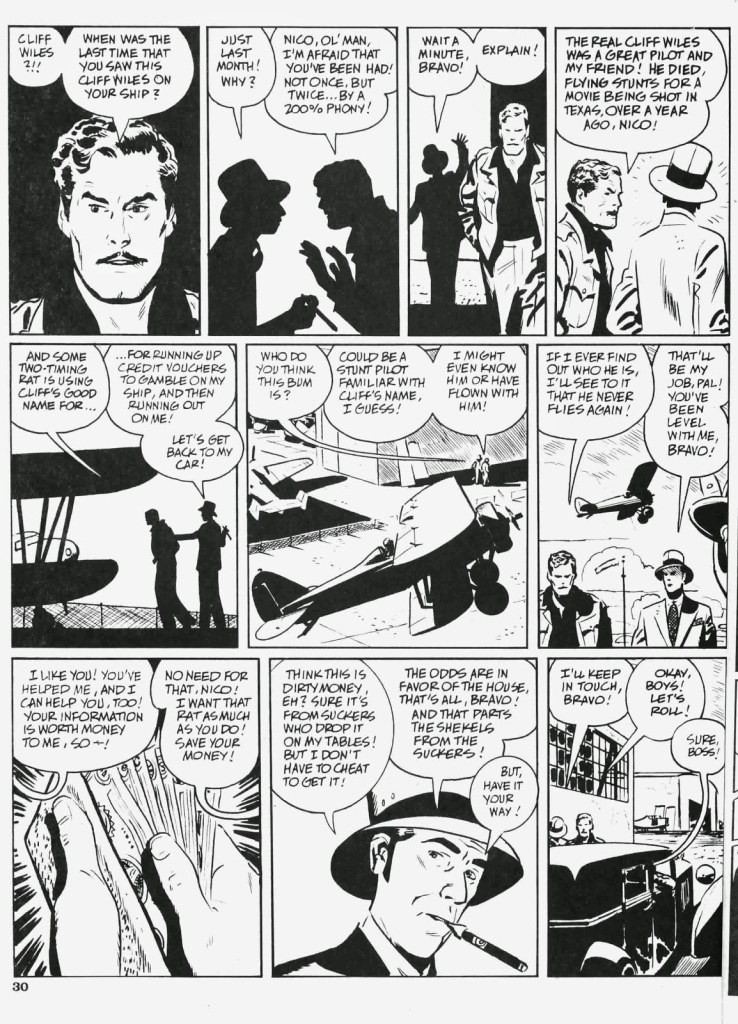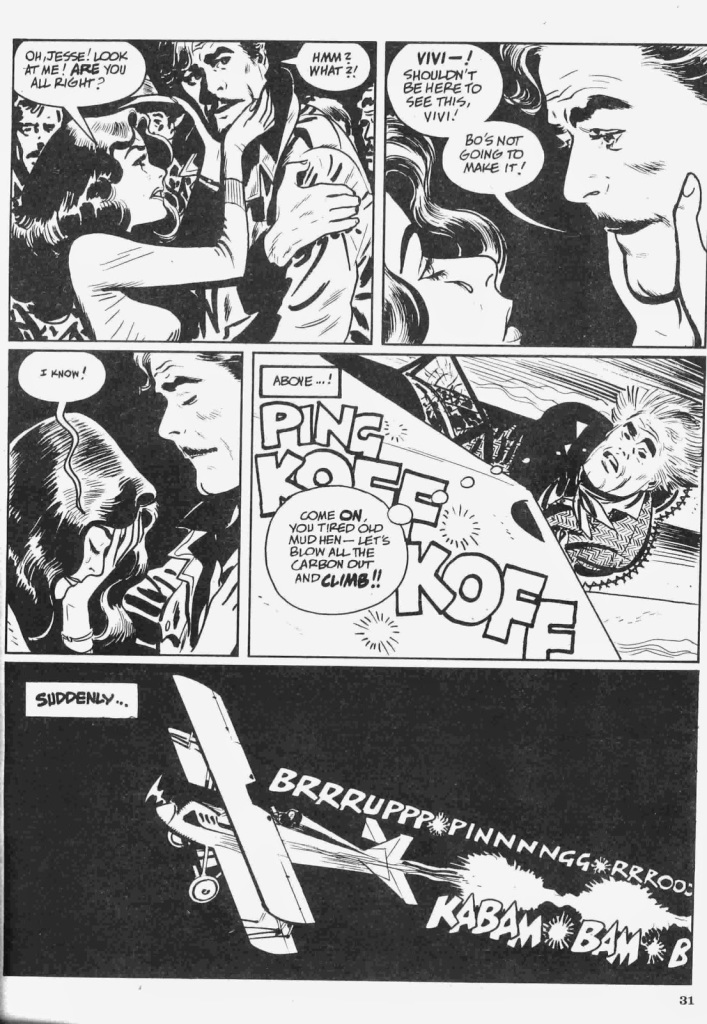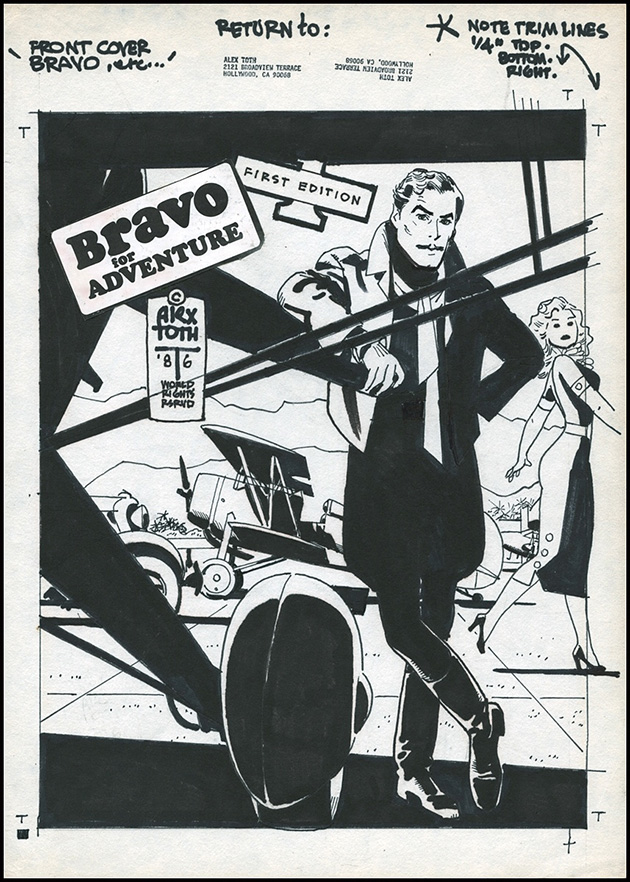Bravo for Adventure by Alex Toth
Everyone has a first Toth story. In interviews, creators who are Alex Toth aficionados are always asked when was the time they discovered Toth’s work.
Back in the 80s, when I needed alternatives to the comic books on the spinner racks, when I was looking back at classic strips like Terry and the Pirates and Prince Valiant to compensate for a lack I found in the industry, I found an ad in a reprint of Roy Crane’s Buz Sawyer that was pushing something called Bravo for Adventure. I had the feeling it was recent work, even if it had all the thematic ammunition of an older era in that one drawing: man with pencil mustache and scarf standing next to an early airplane as a young lady walks by. And in a box, I found the name, Alex Toth. The enigmatic thing about it was that the drawing was devoid of detail, which would have been anathema to me in those days because I loved detail, and yet the image and the name stayed with me for years to come.
This very same image is what you get on the cover of IDW’s new reprint of Bravo for Adventure (except they stripped away the charm of the old black and white by coloring it). It is a handsome edition of what many consider Alex Toth’s finest work, his masterpiece.
If Alex Toth would have been able to secure his lifelong dream to be a syndicated adventure comic strip creator, it would have been something like the content of this book with two important differences: the storytelling format would have been that of strips instead of the comic book pages we get here and it would have been a much larger work, comprising multiple, thick volumes the likes of IDW’s Terry and the Pirates or Dick Tracy instead of this one hundred-page sampler.
Bravo for Adventure follows the exploits of adventure pilot, Jesse Bravo, flying in the exciting vistas of the 1930s (which happens to be the golden decade of the adventure strip). The main story is 48 pages long, providing the reader with a glimpse of what could have been if it had continued. The other two stories were created later. One serves as an introduction to Jesse Bravo and his background and is presented here before the main story. The other is something of a dream sequence in which Toth tips his hat to all of his influences of the adventure strip, people like Noel Sickles, Milton Caniff, Alex Raymond, and Roy Crane. There are also some extra features at the back of the book.
I grew up learning that the word “pastiche” had a negative connotation, and in the introduction of the book, Dean Mullaney calls this work a pastiche, even if he means it in a good way. It could be a good way, I suppose, if a pastiche is nothing less than an homage to the work of previous creators that have been an inspiration to your own work. Though I catalogue the words “pastiche” and “homage” in two different places of my brain, I entered this book with that mindset.
And when I put the book down after having finished it, I found that it had nothing of a pastiche to it. Of course it was an homage to the old adventure strips but it was more than that. Here we have the blueprint for how to take old material and make it sing once again. Alex Toth took the conventions of those types of stories and played them up here to a higher level of humanism. Unlike the grand adventures of heroes foiling bandit armies or chasing down spy rings, the chief conflicts in Bravo had to deal with gambling debts and smearing someone else’s name. It also dealt a bit with loss as the story unfolds, and it played these more sophisticated themes with greater sensitivity than the classic strips themselves. The dialogue is sharp and to the point, with a level of realism that is appropriate for the specific timescape. Every character had a different set of qualities that set them apart from the others. Even the thugs were sympathetic, almost likable, with real personalities. And personalities were rendered by gestures and facial expressions as much as by a character’s speech patterns and intentions, offering rounded characters in every regard a comic book could offer.
I found there is another important difference between Bravo and the older works it is referencing: as mentioned above, Toth is laying out panels on a comic book page rather than a comic strip, and this naturally grants far more freedom. The flow is not truncated by four-panel dailies, and it visually breathes better on the book page than any collection of Dick Tracy strips.
Alex Toth is known as the master without a masterpiece (at least, a masterpiece of any considerable length). Could this 48-page story be used as his proxy for a masterpiece, even if it were unfinished? Just from the fact that this was a personal work for him, that it represented the adventure genre that he loved so much, and that he created every aspect of it with no editorial obstacles, this story has got my vote.



